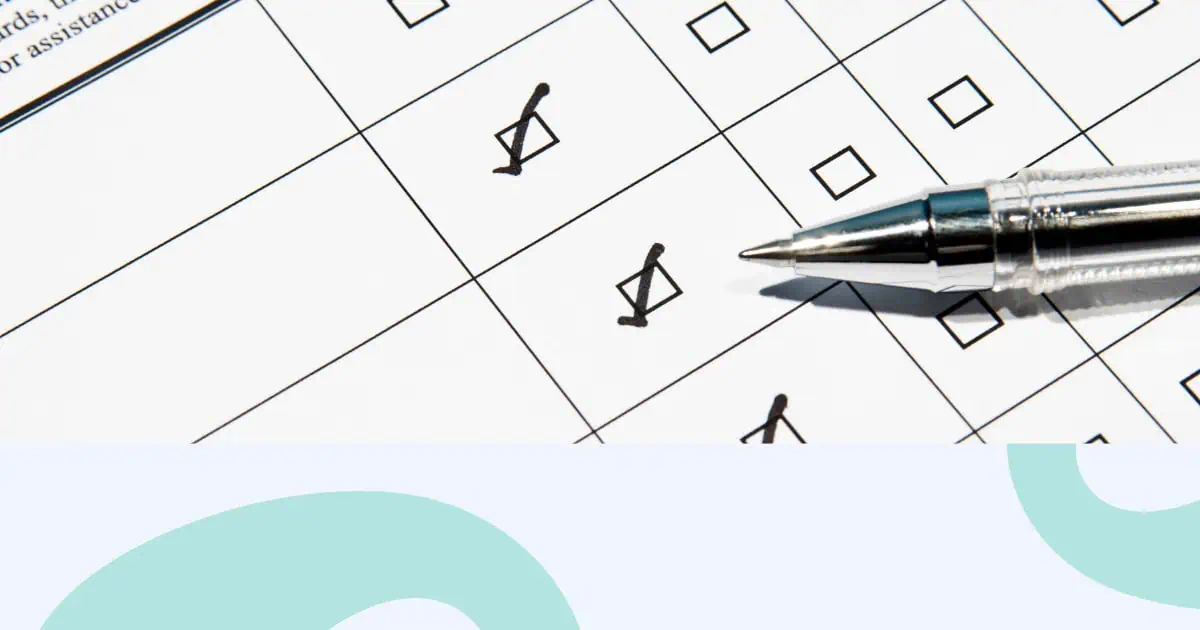పేలవమైన ప్రశ్నాపత్రాల రూపకల్పన వల్ల సంస్థలు ఏటా లక్షలాది మంది సమయం వృధా చేయడం మరియు లోపభూయిష్ట నిర్ణయాలకు లోనవుతాయి. హార్వర్డ్ యొక్క సర్వే పరిశోధనా కార్యక్రమం చెడుగా నిర్మించబడిన సర్వేలు ఉపయోగకరమైన డేటాను సేకరించడంలో విఫలమవడమే కాకుండా - అవి పక్షపాత, అసంపూర్ణ లేదా తప్పుగా అర్థం చేసుకున్న ప్రతిస్పందనలతో నిర్ణయాధికారులను తప్పుదారి పట్టిస్తున్నాయని వెల్లడిస్తుంది.
మీరు ఉద్యోగి నిశ్చితార్థాన్ని కొలిచే HR ప్రొఫెషనల్ అయినా, వినియోగదారు అభిప్రాయాన్ని సేకరించే ఉత్పత్తి నిర్వాహకుడైనా, విద్యా అధ్యయనాలు నిర్వహించే పరిశోధకుడైనా లేదా అభ్యాస ఫలితాలను అంచనా వేసే శిక్షకుడైనా, మీరు ఇక్కడ కనుగొనే ప్రశ్నాపత్రం రూపకల్పన సూత్రాలు ప్యూ రీసెర్చ్ సెంటర్, ఇంపీరియల్ కాలేజ్ లండన్ వంటి సంస్థల నుండి మరియు ప్రముఖ సర్వే మెథడాలజిస్టుల నుండి 40+ సంవత్సరాల అనుభవ పరిశోధన ద్వారా మద్దతు ఇవ్వబడ్డాయి.
ఇది "తగినంత మంచి" సర్వేలను సృష్టించడం గురించి కాదు. ఇది ప్రతివాదులు వాస్తవానికి పూర్తి చేసే, సాధారణ అభిజ్ఞా పక్షపాతాలను తొలగించే మరియు మీరు విశ్వసించగల కార్యాచరణ మేధస్సును అందించే ప్రశ్నాపత్రాలను రూపొందించడం గురించి.
విషయ సూచిక
- చాలా ప్రశ్నాపత్రాలు ఎందుకు విఫలమవుతాయి (మరియు మీది అలా చేయనవసరం లేదు)
- వృత్తిపరమైన ప్రశ్నాపత్రాల యొక్క ఎనిమిది చర్చించలేని లక్షణాలు
- ఏడు-దశల పరిశోధన-ఆధారిత ప్రశ్నాపత్ర రూపకల్పన ప్రక్రియ
- దశ 1: శస్త్రచికిత్స ఖచ్చితత్వంతో లక్ష్యాలను నిర్వచించండి
- దశ 2: అభిజ్ఞా పక్షపాతాన్ని తొలగించే ప్రశ్నలను అభివృద్ధి చేయండి
- దశ 3: విజువల్ హైరార్కీ మరియు యాక్సెసిబిలిటీ కోసం ఫార్మాట్
- దశ 4: కఠినమైన పైలట్ పరీక్షను నిర్వహించండి
- దశ 5: వ్యూహాత్మక పంపిణీతో అమలు చేయండి
- దశ 6: గణాంక కఠినతతో డేటాను విశ్లేషించండి
- దశ 7: సరైన సందర్భంలో కనుగొన్న వాటిని అర్థం చేసుకోండి
- సాధారణ ప్రశ్నాపత్ర రూపకల్పన లోపాలు (మరియు వాటిని ఎలా నివారించాలి)
- AhaSlidesలో ప్రశ్నాపత్రాన్ని ఎలా సృష్టించాలి
- తరచుగా అడిగే ప్రశ్నలు
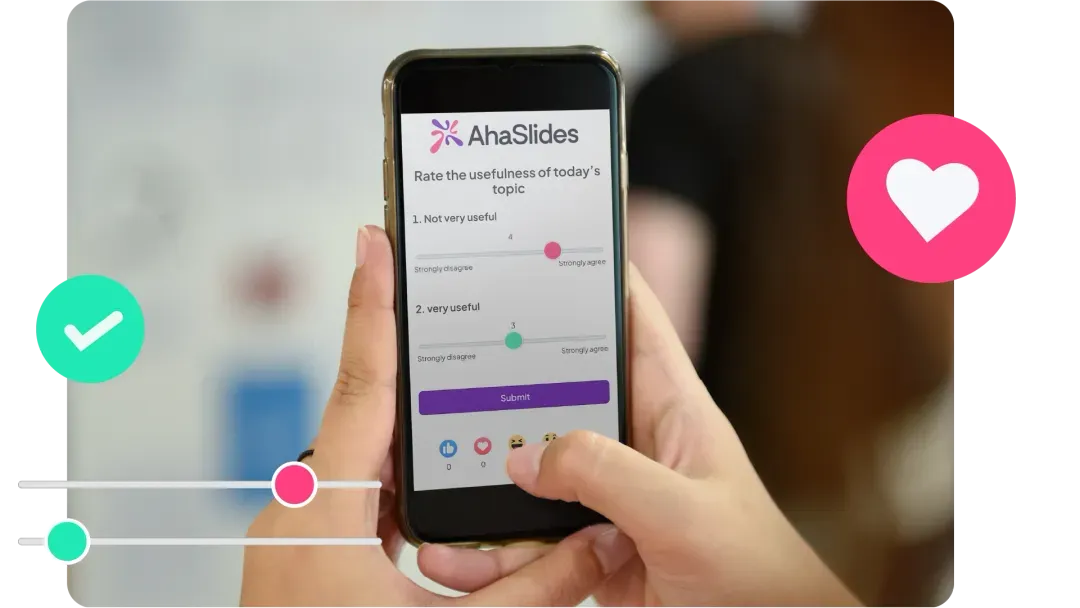
చాలా ప్రశ్నాపత్రాలు ఎందుకు విఫలమవుతాయి (మరియు మీది అలా చేయనవసరం లేదు)
ప్యూ రీసెర్చ్ సెంటర్ సర్వే పరిశోధన ప్రకారం, ప్రశ్నాపత్రాల అభివృద్ధి ఒక కళ కాదు—అది ఒక శాస్త్రం. అయినప్పటికీ చాలా సంస్థలు సర్వే డిజైన్ను సహజంగానే సంప్రదిస్తాయి, ఫలితంగా మూడు క్లిష్టమైన వైఫల్యాలు సంభవిస్తాయి:
- ప్రతిస్పందన పక్షపాతం: ప్రశ్నలు అనుకోకుండా ప్రతివాదులను కొన్ని సమాధానాల వైపు నడిపిస్తాయి, డేటా విలువలేనిదిగా చేస్తాయి.
- ప్రతివాది భారం: కష్టంగా, సమయం తీసుకునేదిగా లేదా భావోద్వేగపరంగా క్షీణింపజేసేదిగా అనిపించే సర్వేలు తక్కువ పూర్తి రేట్లకు మరియు తక్కువ నాణ్యత గల ప్రతిస్పందనలకు దారితీస్తాయి.
- కొలత లోపం: అస్పష్టమైన ప్రశ్నలు అంటే ప్రతివాదులు వాటిని భిన్నంగా అర్థం చేసుకుంటారు, మీ డేటాను అర్థవంతంగా విశ్లేషించడం అసాధ్యం.
శుభవార్త ఏమిటి? ఇంపీరియల్ కాలేజ్ లండన్ మరియు ఇతర ప్రముఖ సంస్థల పరిశోధన ఈ సమస్యలను తొలగించే నిర్దిష్ట, అనుకరణీయ సూత్రాలను గుర్తించింది. వాటిని అనుసరించండి, మీ ప్రశ్నాపత్ర ప్రతిస్పందన రేట్లు 40-60% పెరుగుతాయి మరియు డేటా నాణ్యతను నాటకీయంగా మెరుగుపరుస్తాయి.
వృత్తిపరమైన ప్రశ్నాపత్రాల యొక్క ఎనిమిది చర్చించలేని లక్షణాలు
ప్రశ్నల అభివృద్ధిలోకి ప్రవేశించే ముందు, మీ ప్రశ్నాపత్రం ఫ్రేమ్వర్క్ ఈ ఆధారాల ఆధారిత ప్రమాణాలకు అనుగుణంగా ఉందని నిర్ధారించుకోండి:
- క్రిస్టల్ స్పష్టత: మీరు ఏమి అడుగుతున్నారో ప్రతివాదులు సరిగ్గా అర్థం చేసుకుంటారు. అస్పష్టత చెల్లుబాటు అయ్యే డేటాకు శత్రువు.
- వ్యూహాత్మక సంక్షిప్తత: సందర్భాన్ని త్యాగం చేయకుండా సంక్షిప్తంగా. హార్వర్డ్ పరిశోధన ప్రకారం 10 నిమిషాల సర్వేలు 20 నిమిషాల వెర్షన్ల కంటే 25% ఎక్కువ పూర్తి అవుతాయి.
- లేజర్ విశిష్టత: సాధారణ ప్రశ్నలు అస్పష్టమైన సమాధానాలను ఇస్తాయి. "మీరు ఎంత సంతృప్తి చెందారు?" అనేది బలహీనమైనది. "మీ చివరి సపోర్ట్ టికెట్కు ప్రతిస్పందన సమయంతో మీరు ఎంత సంతృప్తి చెందారు?" అనేది బలంగా ఉంది.
- క్రూరమైన తటస్థత: ప్రముఖ భాషను తొలగించండి. "మా ఉత్పత్తి అద్భుతంగా ఉందని మీరు అంగీకరించలేదా?" అనేది పక్షపాతాన్ని పరిచయం చేస్తుంది. "మీరు మా ఉత్పత్తిని ఎలా రేట్ చేస్తారు?" అనేది అలా చేయదు.
- ఉద్దేశపూర్వక ఔచిత్యం: ప్రతి ప్రశ్న ఒక పరిశోధన లక్ష్యాన్ని నేరుగా ప్రస్తావించాలి. మీరు దానిని ఎందుకు అడుగుతున్నారో వివరించలేకపోతే, దాన్ని తొలగించండి.
- తార్కిక ప్రవాహం: సంబంధిత ప్రశ్నలను కలిపి సమూహపరచండి. సాధారణం నుండి నిర్దిష్టానికి మారండి. సున్నితమైన జనాభా ప్రశ్నలను చివరిలో ఉంచండి.
- మానసిక భద్రత: సున్నితమైన అంశాల విషయంలో, అజ్ఞాతవాసి మరియు గోప్యతను నిర్ధారించుకోండి. డేటా రక్షణ చర్యలను స్పష్టంగా తెలియజేయండి (GDPR సమ్మతి విషయాలు).
- సులభమైన ప్రతిస్పందన: సమాధానాలను సహజంగా రూపొందించండి. అన్ని పరికరాల్లో సజావుగా పనిచేసే దృశ్య సోపానక్రమం, ఖాళీ స్థలం మరియు స్పష్టమైన ప్రతిస్పందన ఫార్మాట్లను ఉపయోగించండి.
ఏడు-దశల పరిశోధన-ఆధారిత ప్రశ్నాపత్ర రూపకల్పన ప్రక్రియ
దశ 1: శస్త్రచికిత్స ఖచ్చితత్వంతో లక్ష్యాలను నిర్వచించండి
అస్పష్టమైన లక్ష్యాలు పనికిరాని ప్రశ్నాపత్రాలను ఉత్పత్తి చేస్తాయి. "కస్టమర్ సంతృప్తిని అర్థం చేసుకోండి" అనేది చాలా విస్తృతమైనది. బదులుగా: "NPSని కొలవండి, ఆన్బోర్డింగ్లో టాప్ 3 ఘర్షణ పాయింట్లను గుర్తించండి మరియు ఎంటర్ప్రైజ్ కస్టమర్లలో పునరుద్ధరణ సంభావ్యతను నిర్ణయించండి."
లక్ష్య నిర్దేశం కోసం ముసాయిదా: మీ పరిశోధన రకాన్ని (అన్వేషణాత్మక, వివరణాత్మక, వివరణాత్మక లేదా అంచనా వేయదగిన) స్పష్టం చేయండి. అవసరమైన ఖచ్చితమైన సమాచారాన్ని పేర్కొనండి. లక్ష్య జనాభాను ఖచ్చితంగా నిర్వచించండి. లక్ష్యాలు ప్రక్రియలను కాదు, కొలవగల ఫలితాలను మార్గనిర్దేశం చేస్తాయని నిర్ధారించుకోండి.
దశ 2: అభిజ్ఞా పక్షపాతాన్ని తొలగించే ప్రశ్నలను అభివృద్ధి చేయండి
ఇంపీరియల్ కాలేజ్ పరిశోధన ప్రకారం అంగీకారం-అంగీకరించకపోవడం అనే ప్రతిస్పందన ఫార్మాట్లు "అంశాలను ప్రదర్శించడానికి చెత్త మార్గాలలో" ఒకటి, ఎందుకంటే అవి అంగీకార పక్షపాతాన్ని పరిచయం చేస్తాయి - కంటెంట్తో సంబంధం లేకుండా ప్రతివాదులు అంగీకరించే ధోరణి. ఈ ఒక్క లోపం మీ మొత్తం డేటాసెట్ను చెల్లదు.
ఆధారాల ఆధారిత ప్రశ్న రూపకల్పన సూత్రాలు:
- ప్రశ్నల రూపంలో పద అంశాలు, ప్రకటనలుగా కాదు: "మా సపోర్ట్ టీం ఎంత సహాయకారిగా ఉంది?" అనేది "మా సపోర్ట్ టీం సహాయకారిగా ఉంది (అంగీకరిస్తున్నాను/అంగీకరించలేదు)" కంటే మెరుగ్గా ఉంది.
- మౌఖికంగా లేబుల్ చేయబడిన ప్రమాణాలను ఉపయోగించండి: ప్రతి ప్రతిస్పందన ఎంపికను కేవలం ముగింపు బిందువులకు బదులుగా ("ఏ మాత్రం ఉపయోగకరంగా లేదు, కొంచెం ఉపయోగకరంగా ఉంది, మధ్యస్తంగా ఉపయోగకరంగా ఉంది, చాలా ఉపయోగకరంగా ఉంది, చాలా ఉపయోగకరంగా ఉంది") లేబుల్ చేయండి. ఇది కొలత లోపాన్ని తగ్గిస్తుంది.
- డబుల్ బ్యారెల్ ప్రశ్నలను నివారించండి: "మీరు ఎంత సంతోషంగా మరియు నిమగ్నమై ఉన్నారు?" రెండు విషయాలు అడుగుతుంది. వాటిని వేరు చేయండి.
- తగిన ప్రశ్న ఫార్మాట్లను వర్తింపజేయండి: పరిమాణాత్మక డేటా కోసం క్లోజ్డ్-ఎండ్ (సులభమైన విశ్లేషణ). గుణాత్మక అంతర్దృష్టుల కోసం ఓపెన్-ఎండ్ (సులభమైన సందర్భం). వైఖరుల కోసం లైకర్ట్ స్కేల్స్ (5-7 పాయింట్లు సిఫార్సు చేయబడ్డాయి).
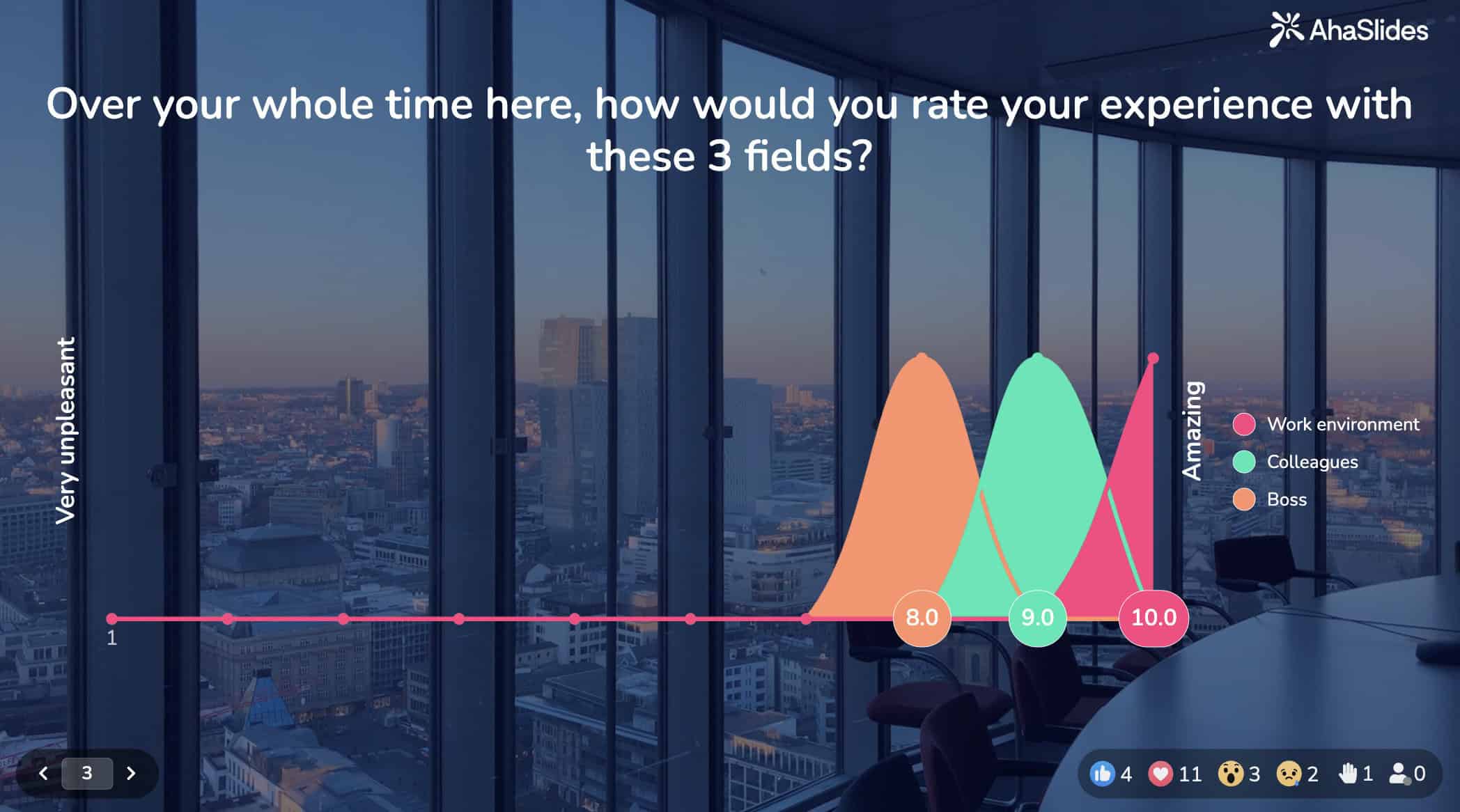
దశ 3: విజువల్ హైరార్కీ మరియు యాక్సెసిబిలిటీ కోసం ఫార్మాట్
దృశ్య రూపకల్పన ప్రతిస్పందన నాణ్యతను నేరుగా ప్రభావితం చేస్తుందని పరిశోధనలు చూపిస్తున్నాయి. పేలవమైన ఫార్మాటింగ్ అభిజ్ఞా భారాన్ని పెంచుతుంది, ప్రతివాదులు సంతృప్తి చెందడానికి దారితీస్తుంది - పూర్తి చేయడానికి తక్కువ-నాణ్యత సమాధానాలను అందిస్తుంది.
క్లిష్టమైన ఆకృతీకరణ మార్గదర్శకాలు:
- సమాన దృశ్య అంతరం: భావనాత్మక సమానత్వాన్ని బలోపేతం చేయడానికి మరియు పక్షపాతాన్ని తగ్గించడానికి స్కేల్ పాయింట్ల మధ్య సమాన దూరాన్ని నిర్వహించండి.
- ప్రత్యేక అసంబద్ధ ఎంపికలు: వాటిని దృశ్యమానంగా వేరు చేయడానికి "N/A" లేదా "సమాధానం ఇవ్వకూడదని కోరుకుంటున్నాను" ముందు అదనపు ఖాళీని జోడించండి.
- విశాలమైన తెల్లని స్థలం: అభిజ్ఞా అలసటను తగ్గిస్తుంది మరియు పూర్తి రేటును మెరుగుపరుస్తుంది.
- పురోగతి సూచికలు: డిజిటల్ సర్వేల కోసం, ప్రేరణను కొనసాగించడానికి పూర్తి శాతాన్ని చూపించండి.
- మొబైల్ ఆప్టిమైజేషన్: ఇప్పుడు 50% కంటే ఎక్కువ సర్వే ప్రతిస్పందనలు మొబైల్ పరికరాల నుండి వస్తున్నాయి. కఠినంగా పరీక్షించండి.
దశ 4: కఠినమైన పైలట్ పరీక్షను నిర్వహించండి
ప్యూ రీసెర్చ్ సెంటర్ పూర్తి విస్తరణకు ముందు అభిజ్ఞా ఇంటర్వ్యూలు, ఫోకస్ గ్రూపులు మరియు పైలట్ సర్వేల ద్వారా విస్తృతమైన ముందస్తు పరీక్షను ఉపయోగిస్తుంది. ఇది అస్పష్టమైన పదాలు, గందరగోళ ఫార్మాట్లు మరియు డేటా నాణ్యతను నాశనం చేసే సాంకేతిక సమస్యలను గుర్తిస్తుంది.
10-15 మంది లక్ష్య జనాభా ప్రతినిధులతో పైలట్ పరీక్ష. పూర్తి సమయాన్ని కొలవండి, అస్పష్టమైన ప్రశ్నలను గుర్తించండి, తార్కిక ప్రవాహాన్ని అంచనా వేయండి మరియు తదుపరి సంభాషణల ద్వారా గుణాత్మక అభిప్రాయాన్ని సేకరించండి. గందరగోళం మాయమయ్యే వరకు పదే పదే సవరించండి.
దశ 5: వ్యూహాత్మక పంపిణీతో అమలు చేయండి
పంపిణీ పద్ధతి ప్రతిస్పందన రేట్లు మరియు డేటా నాణ్యతను ప్రభావితం చేస్తుంది. మీ ప్రేక్షకులు మరియు కంటెంట్ యొక్క సున్నితత్వం ఆధారంగా ఎంచుకోండి:
- డిజిటల్ సర్వేలు: వేగవంతమైనది, అత్యంత ఖర్చుతో కూడుకున్నది, స్కేలబిలిటీ మరియు రియల్-టైమ్ డేటాకు అనువైనది.
- ఇమెయిల్ పంపిణీ: అధిక పరిధి, వ్యక్తిగతీకరణ ఎంపికలు, ట్రాక్ చేయగల కొలమానాలు.
- వ్యక్తిగత పరిపాలన: అధిక ప్రతిస్పందన రేట్లు, తక్షణ స్పష్టత, సున్నితమైన అంశాలకు మంచిది.
ప్రో ఎంగేజ్మెంట్ చిట్కా: సమకాలిక మరియు అసమకాలిక భాగస్వామ్యాన్ని మరియు తక్షణ ఫలితాల విజువలైజేషన్ను అనుమతించే ఇంటరాక్టివ్ సర్వే ప్లాట్ఫారమ్లను ఉపయోగించండి. AhaSlides వంటి సాధనాలు చాలా సరిపోతుందని చెప్పవచ్చు.
దశ 6: గణాంక కఠినతతో డేటాను విశ్లేషించండి
స్ప్రెడ్షీట్ సాఫ్ట్వేర్ లేదా ప్రత్యేక విశ్లేషణ సాధనాలను ఉపయోగించి ప్రతిస్పందనలను క్రమపద్ధతిలో కంపైల్ చేయండి. కొనసాగే ముందు తప్పిపోయిన డేటా, అవుట్లయర్లు మరియు అసమానతల కోసం తనిఖీ చేయండి.
క్లోజ్డ్-ఎండ్ ప్రశ్నలకు, ఫ్రీక్వెన్సీలు, శాతాలు, సగటులు మరియు మోడ్లను లెక్కించండి. ఓపెన్-ఎండ్ ప్రతిస్పందనలకు, నమూనాలను గుర్తించడానికి థీమాటిక్ కోడింగ్ను వర్తింపజేయండి. వేరియబుల్స్ మధ్య సంబంధాలను బహిర్గతం చేయడానికి క్రాస్-టాబులేషన్ను ఉపయోగించండి. ప్రతిస్పందన రేట్లు మరియు జనాభా ప్రాతినిధ్యం వంటి వివరణను ప్రభావితం చేసే డాక్యుమెంట్ కారకాలు.
దశ 7: సరైన సందర్భంలో కనుగొన్న వాటిని అర్థం చేసుకోండి
ఎల్లప్పుడూ అసలు లక్ష్యాలను పునఃసమీక్షించండి. స్థిరమైన ఇతివృత్తాలు మరియు ముఖ్యమైన గణాంక సంబంధాలను గుర్తించండి. పరిమితులు మరియు బాహ్య కారకాలను గమనించండి. కీలకమైన అంతర్దృష్టులను వివరించే ప్రతిస్పందన ఉదాహరణలను కోట్ చేయండి. మరింత పరిశోధన అవసరమయ్యే అంతరాలను గుర్తించండి. సాధారణీకరణ గురించి తగిన జాగ్రత్తతో ఫలితాలను ప్రस्तुतించండి.
సాధారణ ప్రశ్నాపత్ర రూపకల్పన లోపాలు (మరియు వాటిని ఎలా నివారించాలి)
- ప్రముఖ ప్రశ్నలు: "X ముఖ్యమని మీరు అనుకోలేదా?" → "X మీకు ఎంత ముఖ్యమైనది?"
- ఊహించిన జ్ఞానం: సాంకేతిక పదాలు లేదా సంక్షిప్త పదాలను నిర్వచించండి—మీ పరిశ్రమ పరిభాష అందరికీ తెలియదు.
- అతివ్యాప్తి చెందుతున్న ప్రతిస్పందన ఎంపికలు: "0-5 సంవత్సరాలు, 5-10 సంవత్సరాలు" అనేది గందరగోళాన్ని సృష్టిస్తుంది. "0-4 సంవత్సరాలు, 5-9 సంవత్సరాలు" ఉపయోగించండి.
- లోడ్ చేయబడిన భాష: "మా వినూత్న ఉత్పత్తి" పక్షపాతాన్ని పరిచయం చేస్తుంది. తటస్థంగా ఉండండి.
- అధిక పొడవు: ప్రతి అదనపు నిమిషం పూర్తి రేటును 3-5% తగ్గిస్తుంది. ప్రతివాది సమయాన్ని గౌరవించండి.
AhaSlidesలో ప్రశ్నాపత్రాన్ని ఎలా సృష్టించాలి
ఇక్కడ ఉన్నాయి ఆకర్షణీయమైన మరియు శీఘ్ర సర్వేను రూపొందించడానికి 5 సాధారణ దశలు లైకర్ట్ స్కేల్ ఉపయోగించి. మీరు ఉద్యోగి/సేవా సంతృప్తి సర్వేలు, ఉత్పత్తి/లక్షణ అభివృద్ధి సర్వేలు, విద్యార్థుల అభిప్రాయం మరియు మరిన్నింటి కోసం స్కేల్ను ఉపయోగించవచ్చు👇
1 దశ: A కోసం సైన్ అప్ చేయండి ఉచిత AhaSlides ఖాతా.
దశ 2: కొత్త ప్రెజెంటేషన్ను సృష్టించండి లేదా మా వైపు వెళ్ళండిమూస లైబ్రరీ' మరియు 'సర్వేలు' విభాగం నుండి ఒక టెంప్లేట్ని పట్టుకోండి.
3 దశ: మీ ప్రదర్శనలో, 'ని ఎంచుకోండిస్కేల్స్స్లయిడ్ రకం.
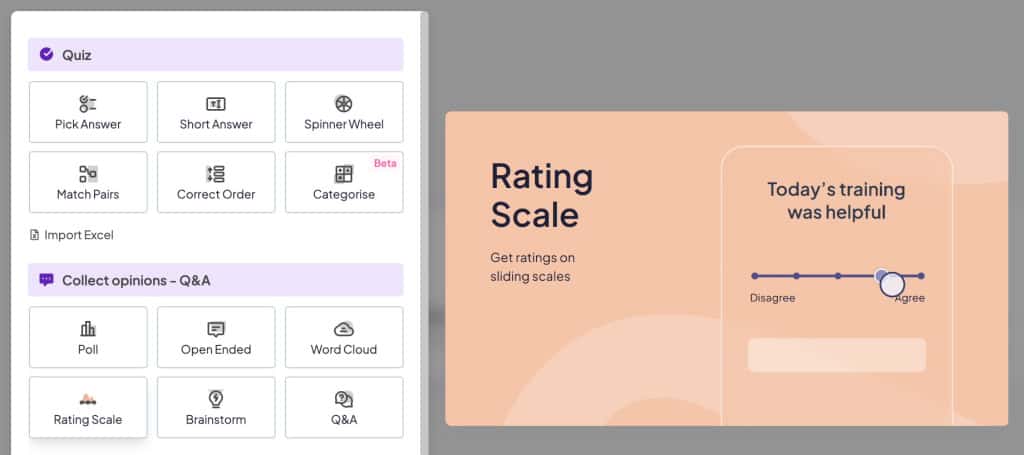
4 దశ: మీ పాల్గొనేవారు రేట్ చేయడానికి మరియు స్కేల్ను 1-5 నుండి సెట్ చేయడానికి ప్రతి స్టేట్మెంట్ను నమోదు చేయండి.
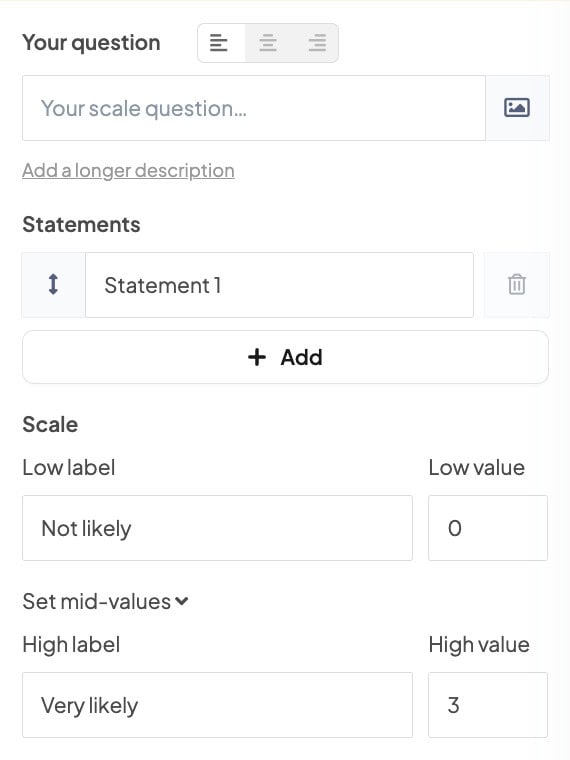
5 దశ: మీరు వాటిని కోరుకుంటే మీ సర్వేను వెంటనే యాక్సెస్ చేయండి, 'పై క్లిక్ చేయండిప్రెజెంట్' బటన్ను క్లిక్ చేయండి, తద్వారా వారు దానిని వీక్షించగలరు వారి పరికరాల్లో. మీరు 'సెట్టింగ్లు' - 'ఎవరు నాయకత్వం వహిస్తారు' - కు కూడా వెళ్లి 'ప్రేక్షకులు (స్వీయ వేగం)'ఎప్పుడైనా అభిప్రాయాలను సేకరించే అవకాశం.
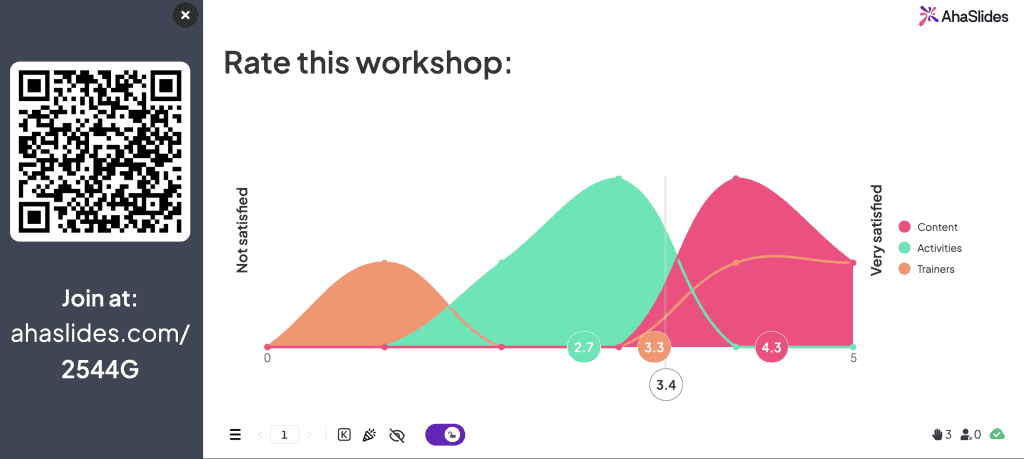
💡 చిట్కా: 'పై క్లిక్ చేయండిఫలితాలు'బటన్ ఫలితాలను Excel/PDF/JPGకి ఎగుమతి చేయడానికి మిమ్మల్ని అనుమతిస్తుంది.
తరచుగా అడిగే ప్రశ్నలు
ప్రశ్నాపత్రం రూపకల్పనలో ఐదు దశలు ఏమిటి?
ప్రశ్నాపత్రాన్ని రూపొందించడానికి ఐదు దశలు #1 - పరిశోధన లక్ష్యాలను నిర్వచించండి, #2 - ప్రశ్నాపత్రం ఆకృతిని నిర్ణయించండి, #3 - స్పష్టమైన మరియు సంక్షిప్త ప్రశ్నలను అభివృద్ధి చేయండి, #4 - ప్రశ్నలను తార్కికంగా అమర్చండి మరియు #5 - ప్రశ్నాపత్రాన్ని ముందుగా పరీక్షించి మెరుగుపరచండి .
పరిశోధనలో 4 రకాల ప్రశ్నాపత్రాలు ఏమిటి?
పరిశోధనలో 4 రకాల ప్రశ్నాపత్రాలు ఉన్నాయి: స్ట్రక్చర్డ్ - అన్ స్ట్రక్చర్డ్ - సెమీ స్ట్రక్చర్డ్ - హైబ్రిడ్.
5 మంచి సర్వే ప్రశ్నలు ఏమిటి?
5 మంచి సర్వే ప్రశ్నలు - ఏమి, ఎక్కడ, ఎప్పుడు, ఎందుకు, మరియు ఎలా ప్రాథమికమైనవి అయితే మీ సర్వేను ప్రారంభించే ముందు వాటికి సమాధానాలు ఇవ్వడం వలన మెరుగైన ఫలితం పొందడంలో సహాయపడుతుంది.
